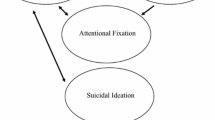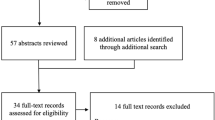Abstract
Attentional biases to suicide-related stimuli are thought to be related to suicidal thoughts and behaviors (STBs). The suicide Stroop task has been used to measure said attentional biases; however, recent investigations have introduced doubt regarding its psychometrics. This prospective study investigated the psychometric properties of a web-based version the suicide Stroop. Participants were N = 591 United States adults with a history of STBs recruited through an online survey recruitment platform. Participants responded to questionnaires and completed the suicide Stroop on their personal computers at two time points, one week apart. Results indicated that mean reaction times to suicide-related and negative stimuli demonstrated acceptable internal consistency reliability at both time points. In addition, evidence was provided for the temporal instability of these stimuli types over time. Neither stimuli type demonstrated evidence of convergent or predictive validity. These results suggest that adaptations to the suicide Stroop thereby improving its psychometric properties is warranted.
Similar content being viewed by others
References
Adler, A., Jager-Hyman, S., Green, K. L., Brown, G. K., Beck, A. T., & Wenzel, A. (2015). Initial psychometric properties of the attentional fixation on suicide experiences questionnaire. Cognitive Therapy and Research, 39(4), 492–498.
Allison, S., Allison, S., Roeger, L., Martin, G., & Keeves, J. (2001). Gender differences in the relationship between depression and suicidal ideation in young adolescents. Australian & New Zealand Journal of Psychiatry, 35(4), 498–503.
Alvarez, R. M., Atkeson, L. R., Levin, I., & Li, Y. (2019). Paying attention to inattentive survey respondents. Political Analysis, 27(2), 145–162.
Beck, A. T., Brown, G. K., & Steer, R. A. (1997). Psychometric characteristics of the Scale for Suicide Ideation with psychiatric outpatients. Behaviour Research and Therapy, 35(11), 1039–1046.
Beck, A. T., Brown, G. K., Steer, R. A., Dahlsgaard, K. K., & Grisham, J. R. (1999). Suicide ideation at its worst point: A predictor of eventual suicide in psychiatric outpatients. Suicide and Life-Threatening Behavior, 29(1), 1–9.
Beck, A. T., Kovacs, M., & Weissman, A. (1979). Assessment of suicidal intention: The Scale for Suicide Ideation. Journal of Consulting and Clinical Psychology, 47(2), 343.
Ben-Haim, M. S., Williams, P., Howard, Z., Mama, Y., Eidels, A., & Algom, D. (2016). The emotional Stroop task: Assessing cognitive performance under exposure to emotional content. Journal of Visualized Experiments, 112. https://doi.org/10.3791/53720
Brown, G. K., Beck, A. T., Steer, R. A., & Grisham, J. R. (2000). Risk factors for suicide in psychiatric outpatients: A 20-year prospective study. Journal of Consulting and Clinical Psychology, 68(3), 371.
Bryan, C. J., Butner, J. E., May, A. M., Rugo, K. F., Harris, J. A., Oakey, D. N., & Bryan, A. O. (2020). Nonlinear change processes and the emergence of suicidal behavior: A conceptual model based on the fluid vulnerability theory of suicide. New Ideas in Psychology, 57, 100758.
Bryan, C. J., Kanzler, K. E., Grieser, E., Martinez, A., Allison, S., & McGeary, D. (2017). A shortened version of the Suicide Cognitions Scale for identifying chronic pain patients at risk for suicide. Pain Practice, 17(3), 371–381.
Bryan, C. J., Rudd, M. D., Wertenberger, E., Etienne, N., Ray-Sannerud, B. N., Morrow, C. E., & Young-McCaughon, S. (2014). Improving the detection and prediction of suicidal behavior among military personnel by measuring suicidal beliefs: An evaluation of the Suicide Cognitions Scale. Journal of Affective Disorders, 159, 15–22.
Burton Denmark, A., Hess, E., & Becker, M. S. (2012). College students’ reasons for concealing suicidal ideation. Journal of College Student Psychotherapy, 26(2), 83–98.
Cha, C. B., Najmi, S., Park, J. M., Finn, C. T., & Nock, M. K. (2010). Attentional bias toward suicide-related stimuli predicts suicidal behavior. Journal of Abnormal Psychology, 119(3), 616.
Cheng, P., Preston, S. D., Jonides, J., Mohr, A. H., Thummala, K., Casement, M., Hsing, P. J., & Deldin, P. J. (2015). Evidence against mood-congruent attentional bias in Major Depressive Disorder. Psychiatry Research, 230(2), 496–505.
Chung, Y., & Jeglic, E. L. (2016). Use of the modified emotional Stroop task to detect suicidality in college population. Suicide and Life-Threatening Behavior, 46(1), 55–66.
Chung, Y., & Jeglic, E. L. (2017). Detecting suicide risk among college students: A test of the predictive validity of the modified emotional Stroop task. Suicide and Life-Threatening Behavior, 47(4), 398–409.
Curtin, S. C., Warner, M., & Hedegaard, H. (2016). Increase in suicide in the United States, 1999–2014 (No. 2016). US Department of Health and Human Services, Centers for Disease Control and Prevention, National Center for Health Statistics.
Der, G., & Deary, I. J. (2006). Age and sex differences in reaction time in adulthood: Results from the United Kingdom Health and Lifestyle Survey. Psychology and Aging, 21(1), 62.
Derryberry, D., & Reed, M. A. (2002). Anxiety-related attentional biases and their regulation by attentional control. Journal of Abnormal Psychology, 111(2), 225.
Egloff, B., Schwerdtfeger, A., & Schmukle, S. C. (2005). Temporal stability of the implicit association test-anxiety. Journal of Personality Assessment, 84(1), 82–88.
Faul, F., Erdfelder, E., Buchner, A., & Lang, A. G. (2009). Statistical power analyses using G* Power 3.1: Tests for correlation and regression analyses. Behavior Research Methods, 41(4), 1149–1160.
Gotlib, I. H., & McCann, C. D. (1984). Construct accessibility and depression: An examination of cognitive and affective factors. Journal of Personality and Social Psychology, 47(2), 427.
Greenwald, A. G., & Farnham, S. D. (2000). Using the implicit association test to measure self esteem and self-concept. Journal of Personality and Social Psychology, 79(6), 1022.
Hamedi, A., Colborn, V. A., Bell, M., Chalker, S. A., & Jobes, D. A. (2019). Attentional bias and the Suicide status form: Behavioral perseveration of written responses. Behaviour Research and Therapy, 120, 103403.
Hanna, D., White, R., Lyons, K., McParland, M. J., Shannon, C., & Mulholland, C. (2011). The structure of the Beck Hopelessness Scale: A confirmatory factor analysis in UK students. Personality and Individual Differences, 51(1), 17–22.
Heise, D. R. (1969). Separating reliability and stability in test-retest correlation. American Sociological Review, 93–101.
Holden, R. R., Mehta, K., Cunningham, E. J., & McLeod, L. D. (2001). Development and preliminary validation of a scale of psychache. Canadian Journal of Behavioural Science/revue Canadienne Des Sciences Du Comportement, 33(4), 224.
Inquisit 5 [Computer software]. (2016). Retrieved from https://www.millisecond.com
Johnson, D. R. (2009). Emotional attention set-shifting and its relationship to anxiety and emotion regulation. Emotion, 9(5), 681.
Joyal, M., Wensing, T., Levasseur-Moreau, J., Leblond, J., Sack, T., & A., & Fecteau, S. (2019). Characterizing emotional Stroop interference in posttraumatic stress disorder, major depression and anxiety disorders: A systematic review and meta-analysis. PLoS ONE, 14(4), e0214998.
Kleiman, E. M., Turner, B. J., Fedor, S., Beale, E. E., Huffman, J. C., & Nock, M. K. (2017). Examination of real-time fluctuations in suicidal ideation and its risk factors: Results from two ecological momentary assessment studies. Journal of Abnormal Psychology, 126(6), 726.
Kleiman, E. M., & Nock, M. K. (2018). Real-time assessment of suicidal thoughts and behaviors. Current Opinion in Psychology, 22, 33–37.
Klonsky, E. D., & May, A. M. (2015). The three-step theory (3ST): A new theory of suicide rooted in the “ideation-to-action” framework. International Journal of Cognitive Therapy, 8(2), 114–129.
Kroenke, K., Spitzer, R. L., & Williams, J. B. (2001). The PHQ-9: Validity of a brief depression severity measure. Journal of General Internal Medicine, 16(9), 606–613.
Kroenke, K., Strine, T. W., Spitzer, R. L., Williams, J. B., Berry, J. T., & Mokdad, A. H. (2009). The PHQ-8 as a measure of current depression in the general population. Journal of Affective Disorders, 114(1–3), 163–173.
Moriarty, A. S., Gilbody, S., McMillan, D., & Manea, L. (2015). Screening and case finding for major depressive disorder using the Patient Health Questionnaire (PHQ-9): a meta-analysis. General Hospital Psychiatry, 37, 567–576.
Moscardini, E. H., Aboussouan, A. B., Bryan, C. J., & Tucker, R. P. (2020). Suicide specific cognitions, attentional fixation, and worst-point suicidal ideation. Suicide and Life-Threatening Behavior, 50(4), 899.
National Institute of Mental Health (NIMH). (2020). The National Institute of Mental Health strategic plan. Retrieved April 26, 2021 from http://www.nimh.nih.gov/about/strategic-planning-reports/index.shtml#strategic-objective1
O’Connor, R. C., & Nock, M. K. (2014). The psychology of suicidal behaviour. The Lancet Psychiatry, 1(1), 73–85.
Osman, A., Bagge, C. L., Gutierrez, P. M., Konick, L. C., Kopper, B. A., & Barrios, F. X. (2001). The Suicidal Behaviors Questionnaire-Revised (SBQ-R): Validation with clinical and nonclinical samples. Assessment, 8(4), 443–454.
Rogers, M. L., Stanley, I. H., Hom, M. A., Chiurliza, B., Podlogar, M. C., & Joiner, T. E. (2018). Conceptual and empirical scrutiny of covarying depression out of suicidal ideation. Assessment, 25(2), 159–172.
Rudd, M. D. (2006). Fluid vulnerability theory: A cognitive approach to understanding the process of acute and chronic suicide risk. Cognition and Suicide: Theory, Research, and Therapy (pp. 355–368).
Smith, K. E., Mason, T. B., Juarascio, A., Weinbach, N., Dvorak, R., Crosby, R. D., & Wonderlich, S. A. (2020). The momentary interplay of affect, attention bias, and expectancies as predictors of binge eating in the natural environment. International Journal of Eating Disorders, 53(4), 586–594.
Spanakis, P., Jones, A., Field, M., & Christiansen, P. (2019). A stroop in the hand is worth two on the laptop: Superior reliability of a smartphone based alcohol stroop in the real world. Substance Use & Misuse, 54(4), 692–698.
Stenzel, J. S., Höller, I., Rath, D., Hallensleben, N., Spangenberg, L., Glaesmer, H., & Forkmann, T. (2020). Do feelings of defeat and entrapment change over time? An investigation of the integrated motivational—Volitional model of suicidal behaviour using ecological momentary assessments. International Journal of Environmental Research and Public Health, 17(13), 4685.
Wenzel, A., & Beck, A. T. (2008). A cognitive model of suicidal behavior: Theory and treatment. Applied and Preventive Psychology, 12(4), 189–201.
Whelan, R. (2008). Effective analysis of reaction time data. The Psychological Record, 58(3), 475–482.
Williams, J. M. G., & Broadbent, K. (1986). Distraction by emotional stimuli: Use of a Stroop task with suicide attempters. British Journal of Clinical Psychology, 25(2), 101–110.
Wilson, K. M., Millner, A. J., Auerbach, R. P., Glenn, C. R., Kearns, J. C., Kirtley, O. J., & Cha, C. B. (2019). Investigating the psychometric properties of the Suicide Stroop Task. Psychological Assessment, 31(8), 1052.
Author information
Authors and Affiliations
Contributions
Both EHM and RPT contributed to study concept and study design. EHM performed data analyses and interpretation and drafted the paper. RPT provided critical revisions.
Corresponding author
Ethics declarations
Ethical Approval
Approved by the Institutional Review Board at Louisiana State University (#4277).
Conflict of Interest
Emma H. Moscardini and Raymond P. Tucker declare that they have no conflict of interest.
Additional information
Publisher's Note
Springer Nature remains neutral with regard to jurisdictional claims in published maps and institutional affiliations.
Rights and permissions
Springer Nature or its licensor holds exclusive rights to this article under a publishing agreement with the author(s) or other rightsholder(s); author self-archiving of the accepted manuscript version of this article is solely governed by the terms of such publishing agreement and applicable law.
About this article
Cite this article
Moscardini, E.H., Tucker, R.P. Psychometric Properties of an Online Administered Version of the Suicide Stroop Task. J Psychopathol Behav Assess 45, 122–135 (2023). https://doi.org/10.1007/s10862-022-09994-4
Accepted:
Published:
Issue Date:
DOI: https://doi.org/10.1007/s10862-022-09994-4




